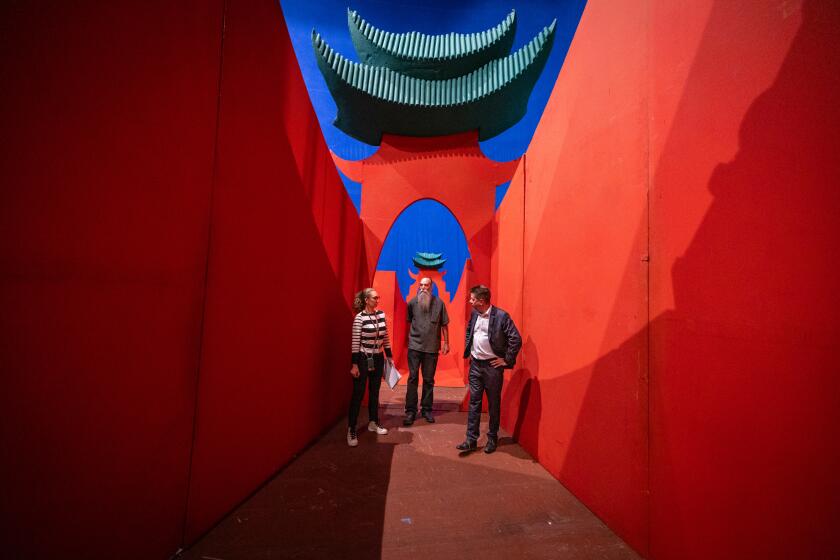Stark Images Feed Sensational Appetite
Catherine Chalmers’ color pictures of insects devouring a plump red tomato and reptiles gobbling up insects and mammals are the photographic equivalent of extreme nature programs. Like TV shows that pretend to educate viewers about the planet’s natural splendor when their real goal is to titillate us with the spectacle of danger and death, her 40-by-60-inch prints generate cheap, voyeuristic thrills.
Their visual impact is immediate and undeniable. Shot against spotless white backdrops, each of the New York photographer’s images combines the clinical precision of science experiments with the stark sensuality of fashion photography. Imagine what Richard Avedon might produce if he collaborated with research laboratory technicians and you’ll have an idea of the stylish, high-contrast dramas Chalmers sets up in her sensationalistic pictures.
Titled “Prey and Eat,” her exhibition at the University Art Museum, Cal State Long Beach, accompanies the publication of a handsome coffee-table book. In the main gallery, a three-part story unfolds across the glossy surfaces of nine C-prints from Chalmers’ “Food Chain” series (1994-96).
The first three photographs feature an army of tobacco hornworm larvae feasting on a tomato that’s so ripe and juicy it could be the star of a Madison Avenue ad campaign. The bright-green caterpillars, which eventually will become tobacco horn moths, are equally photogenic: Adorned with chevron patterns and diagonal, black-and-white stripes, their segmented bodies bend sensually. Trained as a painter, Chalmers composes her photographs to evoke familiar styles and emotions, from the disciplined restraint of hard-edge abstraction to the messy abandon of splatter painting.
The tables turn in the second group of prints, which chronicles a confrontation between a caterpillar and a praying mantis. The composition of the first picture in this time-lapse sequence recalls Adolph Gottlieb’s pictographic abstractions, with the mantis’ spindly legs forming a menacing asterisk over the plump worm, whose vulnerability is accentuated by its horizontal position.
In the next shot, the mantis’ powerful mandibles do their deadly work as its vise-like jaws extract its prey’s bright-red innards, which are as fleshy and juicy as the inside of a tomato. Not without a sense of humor, Chalmers’ images declare: You are what you eat--dinner.
The third group drives this point home by depicting a frog that toys with a praying mantis before swallowing it in a single gulp. The most anthropomorphic of her subjects, the frog appears to grin like a Cheshire cat in one picture, to be as sick as a dog in another, and as drunk as a skunk in a third.
The second gallery displays seven works from Chalmers’ “Pinkies” series (1995-97), which outlines a step-by-step narrative that begins with the birth of a litter of mice and ends with a single mouse being swallowed by a corn snake. If not for their size and the fashionable backdrops against which they’re shot, the four images that focus on the feeding constrictor could be illustrations in a high-end zoological textbook.
Although Chalmers’ specimens change from one body of work to the next, the story they tell gets repetitive. As an artist, Chalmers’ talents lie in her capacity to make eye-grabbing photographs. Unfortunately, once her works get your attention, they do very little with it. This gives them the presence of overblown posters, snazzy graphic designs that leave too little to the imagination to compel you to keep looking.
*
* “Prey and Eat,” University Art Museum, Cal State Long Beach, 1250 Bellflower Blvd., Long Beach, (562) 985-5761, through April 29. Closed Mondays.
More to Read
The biggest entertainment stories
Get our big stories about Hollywood, film, television, music, arts, culture and more right in your inbox as soon as they publish.
You may occasionally receive promotional content from the Los Angeles Times.






